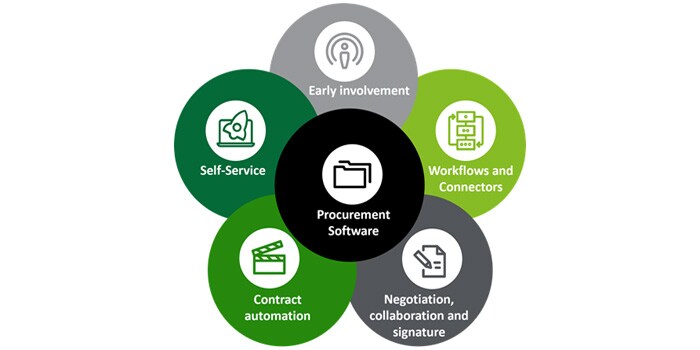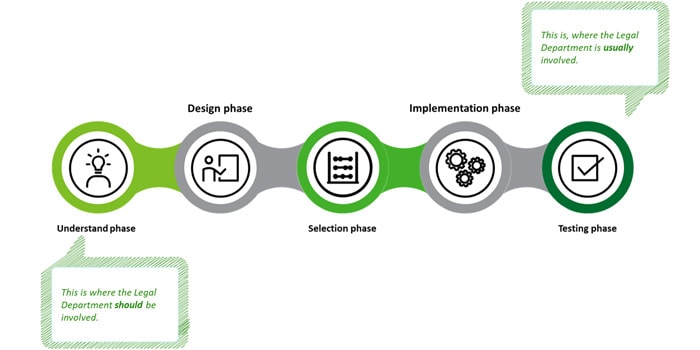Article

Five steps to turn your new procurement software into a success for Legal
The introduction of a new procurement system is a chance to optimize processes and reduce workload not only on the procurement side but also for the legal department
Legal and procurement departments are closely connected and benefit greatly from a shared understanding of each other’s needs and ways of working, and from clearly established processes and areas of responsibility. The implementation of a new procurement solution is a powerful moment for improving the relationship between Legal and Procurement. The following five steps will help Legal own this moment of change and make the most out of it.
Explore Content
- 1. Early involvement
- 2. Each email costs you 5 minutes: Workflows and Connectors
- 3. Contract negotiation, collaboration and signature
- 4. Contract automation
- 5. The holy grail: Self-Service

1. Early involvement
The process of establishing a new procurement software has many stakeholders: Procurement, IT, finance, tax, data protection office and of course Legal. It is crucial for the legal department to be an active participant in this process from the very beginning. As soon as the organization consider introducing new procurement software, your Legal Department should make sure it is involved in the process.

Already at the start of the project you should start formulating Legal’s requirements for the system. At this stage there needn’t be a complete functional and technical requirements list, but initial thoughts about what the system ought to accomplish to make your life easier and your work more efficient.
2. Each email costs you 5 minutes: Workflows and Connectors
A crucial part of the daily work of a legal department relating to procurement is reviewing procurement contracts. Even with well-designed and established processes the communication between Legal and Procurement is usually based on emails. However, emails have some decisive disadvantages: There is no structured data exchange, and they are very hard to monitor. Everyone loses time – typically at least five minutes per email. What's more, you must transfer the data from the email manually into your system, whether it being a simple Excel file or a state-of-the-art contract management system.
A powerful workflow engine for approvals, signatures and data capturing can save your organization thousands of work hours per year. The workflows can be monitored by your whole team, so nothing gets lost, and you can quickly identify bottlenecks and add additional resources where they are needed. The right connectors (or APIs) are crucial if you are using your own legal software. Nothing impedes the work more than having to transfer data manually between systems.
Setting up these features might require considerable effort by the organization. But this investment will save your organization from the cost of "old-school" e-mail communication.
3. Contract negotiation, collaboration and signature
Contract negotiations are often an elongated process, during which drafts are sent back and forth between the organizations. A powerful feature of procurement software is the ability for you and your vendor to propose and comment on changes to a draft in the procurement system itself, so the need for extensive e-mail communication is again drastically reduced.
In addition, your procurement platform should allow for uploading external contract documents, e.g. in order to cover cases where an important vendor is unwilling to work within your system. An Optical Character Recognition (OCR) feature makes scanned documents machine readable and will make your work easier. Compare functionalities can help you to identify changes between your draft and the draft of the vendor. Finally, you should have the possibility to define meta data for your contracts to save important information for reporting or future contract reviews – a standard feature for most procurement platforms.
Electronic signature, already standard in countries like the USA, is more and more accepted in b2b contracts across Europe. You should make sure that the procurement software supports standard e-signature solutions, especially the ones already being used in your organization.
4. Contract automation
If it is your organization that regularly proposes the contract to your vendor, it is advisable for Legal to insist on a strong text generation engine in the procurement software. This enables Legal to set up dynamic contract templates that users can pre-fill by answering a questionnaire. The answers provided alter the language in the contract (e.g. a paragraph on ordinary termination is included if the contract duration is chosen to be indefinite, while such paragraph is hidden in case of a fixed contract term). This saves time, but often also improves the quality and consistency of your documents.
For the legal department this may require a change of perspective: Usually a legal document is drafted for one particular situation. A dynamic template must be drafted with all cases in mind. So, it is advisable to make it simpler and more general in its language.
An advanced legal department may even choose to go a step further and opt for clause-based contracting in the platform. Many of your contracts share the same or similar clauses. The idea of clause-based contracting is to enter all clauses into a central clause library and generate individual contracts by combining the right clauses. The upfront investment is higher, but you will get a much deeper level of control and granular data on your contracts.
5. The holy grail: Self-Service
In many organizations eighty percent of all procurement contracts are taken from static templates with no significant changes to the text. Nevertheless, it is usually policy, that Legal has to review the contracts before they are signed. The result is: Procurement must wait for Legal to finish the review, a legal professional has to read the same text over and over again for the small chance that there could be an error, or a changed clause, with the organization losing money along the way.
A self-service functionality combines all the features above and has an enormous productivity boost. If Procurement wants to create a standard contract it just fills out a questionnaire in the procurement software. The document is automatically generated from a dynamic template, that is pre-approved by Legal. Depending on how the contracting workflow is set up, the entire document – or only specific clauses – could be locked for editing by Procurement, so Legal can be sure that the generated contract contains only the pre-approved text. Absent of the need to deviations from the standard wording, no Legal review is necessary, and the document is ready for signature within seconds.
This feature offers great benefits to Legal but also needs close alignment with Procurement to produce a result that benefits both sides. If your organization is not yet experienced with self-service contract generation, starting with simple contracts like an NDA has proven to be a good starting point.
Conclusion
The introduction of a new procurement system is a complex process. It brings along a change of the ways of working for both Procurement and Legal – which can be a pivotal moment for Legal to deepen its relationship with Procurement and at the same time leverage the new system’s features. But doing so requires a commitment of time and effort from the legal department. Experienced legal operations professionals can help navigate the process and empower the lawyers to make their voice heard. For Legal, taking an active part in the implementation of a new procurement system means to have a say in how Legal will work in the future.
Click here for more information on clause-based
contracting
Recommendations
From template collection to the clause database
Exploit advantages and avoid typical mistakes – the Dos and Don'ts of clausification
The Legal Front Door: An introduction to digital legal matter intake
Part 1: The benefits of a Legal Front Door


